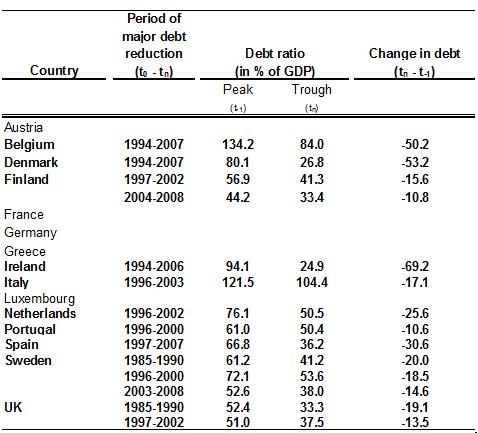Nov 222010
Christiane Nickel, Philipp Rother, and Lilli Zimmermann of VoxEU.org, a portal set up by the Centre for Economic Policy Research, in November 2010 reported how some European countries were able to rapidly lower government debt. Some of these strategies could be implemented in the U.S. to lower its government debt.
- As a government borrows more money, debt holders require higher interest rates. This interest rate increase effects the sustainability additional government debt.
- Secondly, high government debt may harm economic growth by crowding-out private investment. The private sector may then reduce investment due to a lower rate of return.
- Third, a country with a high debt level has less opportunity or flexibility to respond to economic shocks.
- “For the successful consolidation experiences in the EU, the average total debt reduction per country amounted to almost 37 percentage points of GDP.”
- There are three primary ways to reduce government debt: run a budget surplus by reducing spending, increase taxes, or grow the economy.
- Inflation “is not a viable option for successful public debt reduction.”
- The factors that affect major debt reduction:
- “First, major debt reductions are mainly driven by decisive and lasting (rather than timid and short-lived) fiscal consolidation efforts focused on reducing government expenditure, in particular, cuts in social benefits and public wage spending. Revenue-based consolidations seem to have a tendency to be less successful.”
- “Second, robust real GDP growth also increases the likelihood of a major debt reduction because it helps countries to ‘grow their way out’ of indebtedness. Here, the literature also points to a positive feedback effect with decisive expenditure-based fiscal consolidation because this type of consolidation appears to foster growth, in particular in times of severe fiscal imbalances.”
- “Third, high debt servicing costs exert a disciplinary effect via market forces and require governments to set up credible plans to stop and reverse the increase in debt ratios.”
- Spending cuts tend to work better than tax increases.
- Governments should use economic upswings for spending cuts rather than tax breaks.

To read the entire article, click on Major public debt reductions: Lessons from the past, lessons for the future.
Sorry, the comment form is closed at this time.